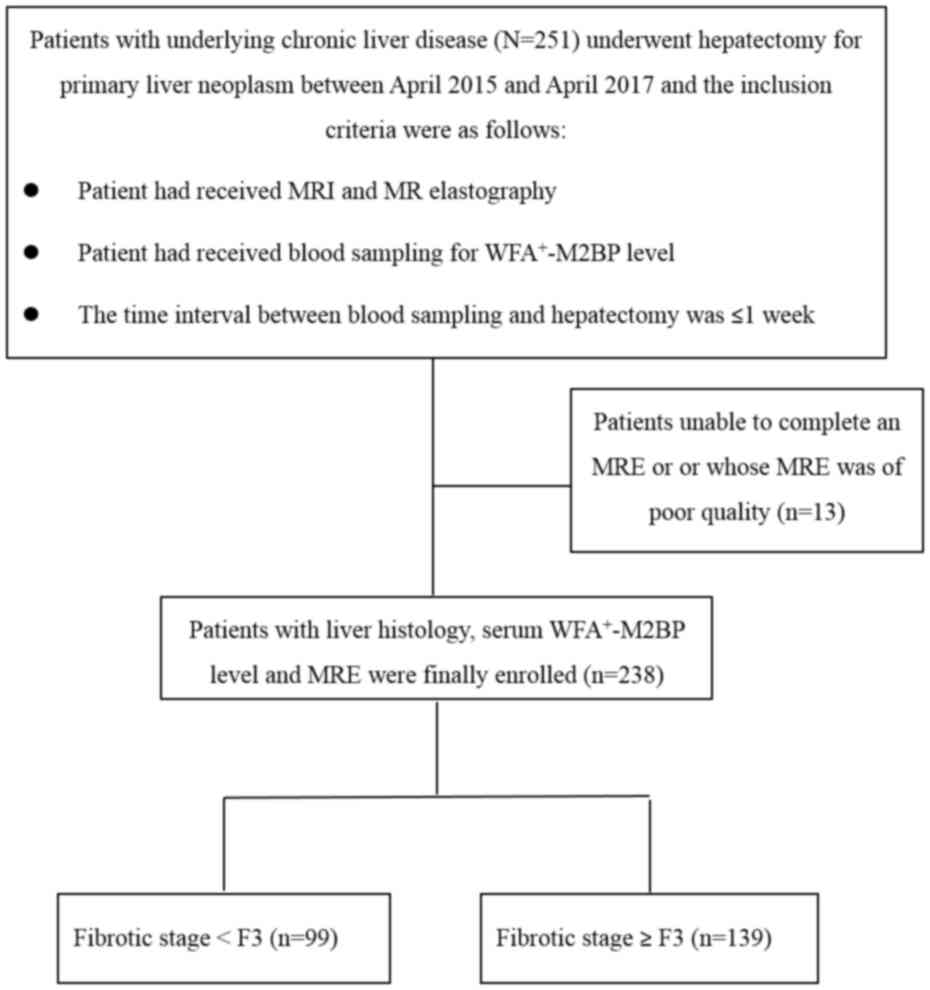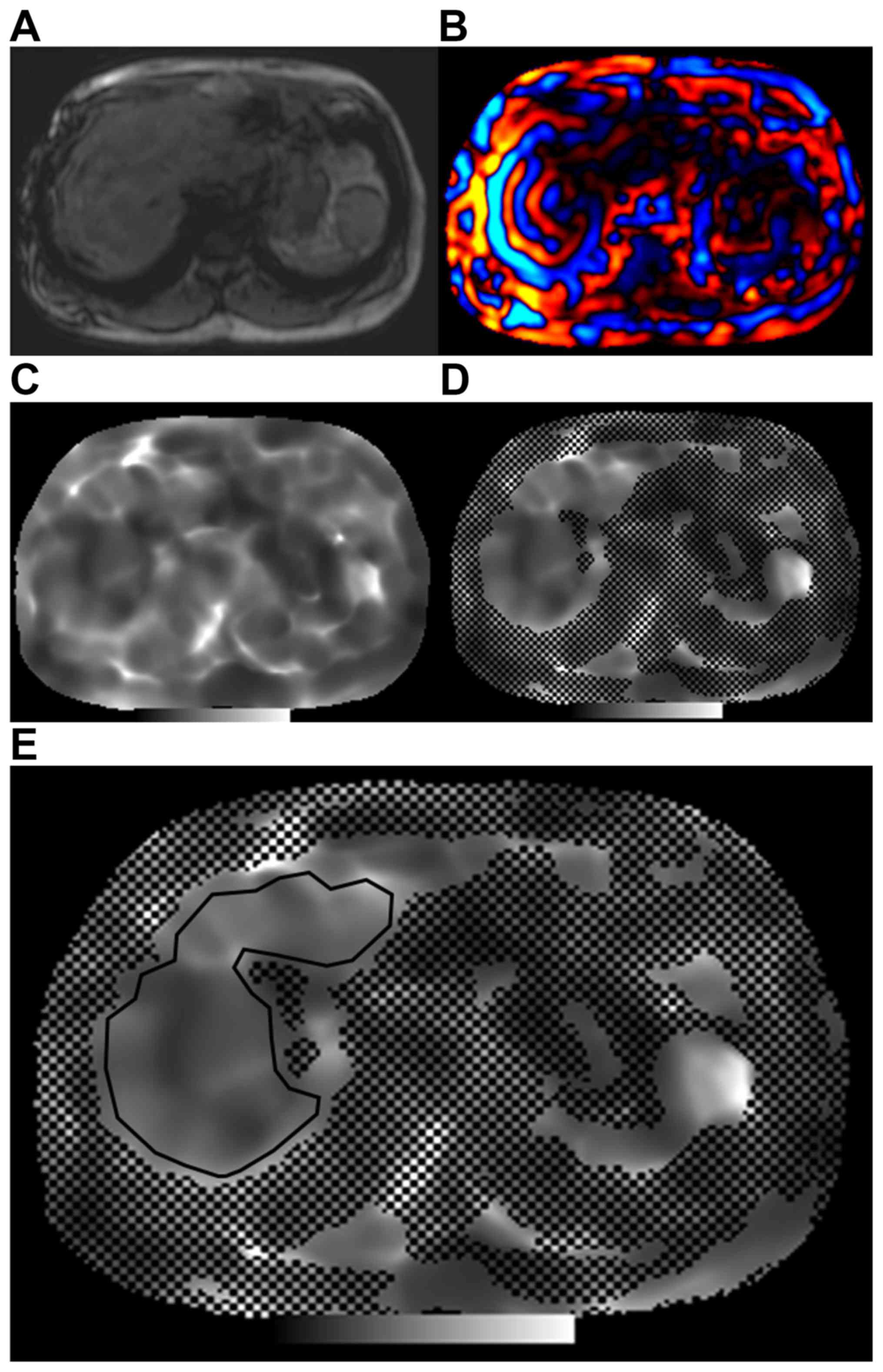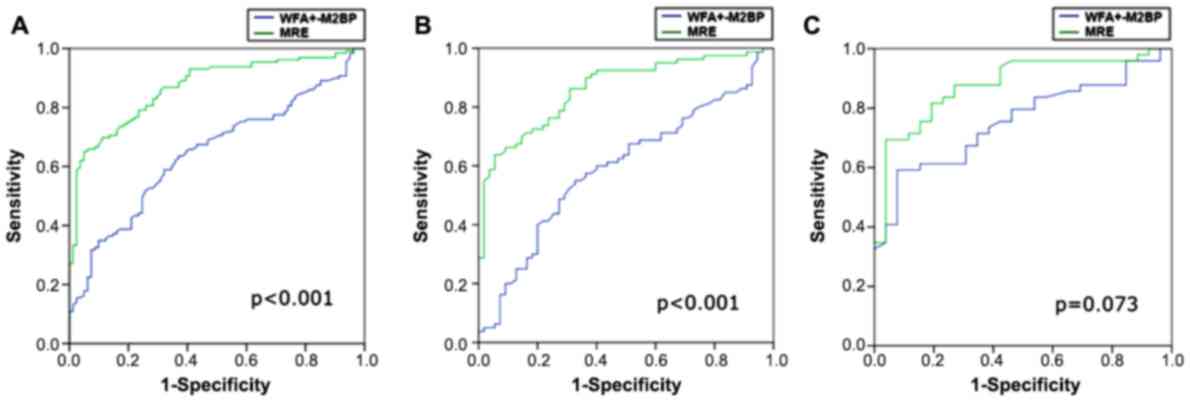|
1
|
Barr RG, Ferraioli G, Palmeri ML, Goodman
ZD, Garcia-Tsao G, Rubin J, Garra B, Myers RP, Wilson SR, Rubens D
and Levine D: Elastography assessment of liver fibrosis: Society of
radiologists in ultrasound consensus conference statement.
Radiology. 276:845–861. 2015.PubMed/NCBI View Article : Google Scholar
|
|
2
|
Marcellin P, Gane E, Buti M, Afdhal N,
Sievert W, Jacobson IM, Washington MK, Germanidis G, Flaherty JF,
Aguilar Schall R, et al: Regression of cirrhosis during treatment
with tenofovir disoproxil fumarate for chronic hepatitis B: A
5-year open-label follow-up study. Lancet. 381:468–475.
2013.PubMed/NCBI View Article : Google Scholar
|
|
3
|
Bedossa P, Dargère D and Paradis V:
Sampling variability of liver fibrosis in chronic hepatitis C.
Hepatology. 38:1449–1457. 2003.PubMed/NCBI View Article : Google Scholar
|
|
4
|
Cui J, Heba E, Hernandez C, Haufe W,
Hooker J, Andre MP, Valasek MA, Aryafar H, Sirlin CB and Loomba R:
Magnetic resonance elastography is superior to acoustic radiation
force impulse for the diagnosis of fibrosis in patients with
biopsy-proven nonalcoholic fatty liver disease: A prospective
study. Hepatology. 63:453–461. 2016.PubMed/NCBI View Article : Google Scholar
|
|
5
|
Toshima T, Shirabe K, Takeishi K, Motomura
T, Mano Y, Uchiyama H, Yoshizumi T, Soejima Y, Taketomi A and
Maehara Y: New method for assessing liver fibrosis based on
acoustic radiation force impulse: A special reference to the
difference between right and left liver. J Gastroenterol.
46:705–711. 2011.PubMed/NCBI View Article : Google Scholar
|
|
6
|
Ito K, Murotani K, Nakade Y, Inoue T,
Nakao H, Sumida Y, Kamada Y and Yoneda M: Serum Wisteria floribunda
agglutinin-positive Mac-2-binding protein levels and liver
fibrosis: A meta-analysis. J Gastroenterol Hepatol. 32:1922–1930.
2017.PubMed/NCBI View Article : Google Scholar
|
|
7
|
Bedossa P and Poynard T: An algorithm for
the grading of activity in chronic hepatitis C. Hepatology.
24:289–293. 1996.PubMed/NCBI View Article : Google Scholar
|
|
8
|
Kuno A, Sato T, Shimazaki H, Unno S,
Saitou K, Kiyohara K, Sogabe M, Tsuruno C, Takahama Y, Ikehara Y
and Narimatsu H: Reconstruction of a robust glycodiagnostic agent
supported by multiple lectin-assisted glycan profiling. Proteomics
Clin Appl. 7:642–647. 2013.PubMed/NCBI View Article : Google Scholar
|
|
9
|
Kuno A, Ikehara Y, Tanaka Y, Ito K,
Matsuda A, Sekiya S, Hige S, Sakamoto M, Kage M, Mizokami M and
Narimatsu H: A serum ‘sweet-doughnut’ protein facilitates fibrosis
evaluation and therapy assessment in patients with viral hepatitis.
Sci Rep. 3(1065)2013.PubMed/NCBI View Article : Google Scholar
|
|
10
|
DeLong ER, DeLong DM and Clarke-Pearson
DL: Comparing the areas under two or more correlated receiver
operating characteristic curves: A nonparametric approach.
Biometrics. 44:837–845. 1988.PubMed/NCBI
|
|
11
|
Toshima T, Shirabe K, Ikegami T, Yoshizumi
T, Kuno A, Togayachi A, Gotoh M, Narimatsu H, Korenaga M, Mizokami
M, et al: A novel serum marker, glycosylated Wisteria floribunda
agglutinin-positive Mac-2 binding protein (WFA(+)-M2BP), for
assessing liver fibrosis. J Gastroenterol. 50:76–84.
2015.PubMed/NCBI View Article : Google Scholar
|
|
12
|
Abe M, Miyake T, Kuno A, Imai Y, Sawai Y,
Hino K, Hara Y, Hige S, Sakamoto M, Yamada G, et al: Association
between Wisteria floribunda agglutinin-positive Mac-2 binding
protein and the fibrosis stage of non-alcoholic fatty liver
disease. J Gastroenterol. 50:776–784. 2015.PubMed/NCBI View Article : Google Scholar
|
|
13
|
Nishikawa H, Enomoto H, Iwata Y, Hasegawa
K, Nakano C, Takata R, Nishimura T, Yoh K, Aizawa N, Sakai Y, et
al: Clinical significance of serum Wisteria floribunda agglutinin
positive Mac-2-binding protein level and high-sensitivity
C-reactive protein concentration in autoimmune hepatitis. Hepatol
Res. 46:613–621. 2016.PubMed/NCBI View Article : Google Scholar
|
|
14
|
Umemura T, Joshita S, Sekiguchi T, Usami
Y, Shibata S, Kimura T, Komatsu M, Matsumoto A, Ota M and Tanaka E:
Serum wisteria floribunda agglutinin-positive Mac-2-binding protein
level predicts liver fibrosis and prognosis in primary biliary
cirrhosis. Am J Gastroenterol. 110:857–864. 2015.PubMed/NCBI View Article : Google Scholar
|
|
15
|
Yamada N, Sanada Y, Tashiro M, Hirata Y,
Okada N, Ihara Y, Urahashi T and Mizuta K: Serum Mac-2 binding
protein glycosylation isomer predicts grade F4 liver fibrosis in
patients with biliary atresia. J Gastroenterol. 52:245–252.
2017.PubMed/NCBI View Article : Google Scholar
|
|
16
|
Nishikawa H, Enomoto H, Iwata Y, Kishino
K, Shimono Y, Hasegawa K, Nakano C, Takata R, Nishimura T, Yoh K,
et al: Serum Wisteria floribunda agglutinin-positive Mac-2-binding
protein for patients with chronic hepatitis B and C: A comparative
study. J Viral Hepat. 23:977–984. 2016.PubMed/NCBI View Article : Google Scholar
|
|
17
|
Terrault NA, Bzowej NH, Chang KM, Hwang
JP, Jonas MM and Murad MH: AASLD guidelines for treatment of
chronic hepatitis B. Hepatology. 63:261–283. 2016.PubMed/NCBI View Article : Google Scholar
|
|
18
|
Kage M, Shimamatu K, Nakashima E, Kojiro
M, Inoue O and Yano M: Long-term evolution of fibrosis from chronic
hepatitis to cirrhosis in patients with hepatitis C: Morphometric
analysis of repeated biopsies. Hepatology. 25:1028–1031.
1997.PubMed/NCBI View Article : Google Scholar
|
|
19
|
McMahon BJ: The natural history of chronic
hepatitis B virus infection. Hepatology. 49 (Suppl 5):S45–S55.
2009.PubMed/NCBI View Article : Google Scholar
|
|
20
|
Bedossa P: Reversibility of hepatitis B
virus cirrhosis after therapy: Who and why? Liver Int. 35 (Suppl
1):S78–S81. 2015.PubMed/NCBI View Article : Google Scholar
|
|
21
|
AASLD/IDSA HCV Guidance Panel: Hepatitis C
guidance: AASLD-IDSA recommendations for testing, managing, and
treating adults infected with hepatitis C virus. Hepatology 62:
932-954, 2015.
|

















